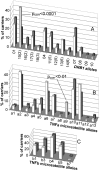Three allele combinations associated with multiple sclerosis
- PMID: 16872485
- PMCID: PMC1557481
- DOI: 10.1186/1471-2350-7-63
Three allele combinations associated with multiple sclerosis
Abstract
Background: Multiple sclerosis (MS) is an immune-mediated disease of polygenic etiology. Dissection of its genetic background is a complex problem, because of the combinatorial possibilities of gene-gene interactions. As genotyping methods improve throughput, approaches that can explore multigene interactions appropriately should lead to improved understanding of MS.
Methods: 286 unrelated patients with definite MS and 362 unrelated healthy controls of Russian descent were genotyped at polymorphic loci (including SNPs, repeat polymorphisms, and an insertion/deletion) of the DRB1, TNF, LT, TGFbeta1, CCR5 and CTLA4 genes and TNFa and TNFb microsatellites. Each allele carriership in patients and controls was compared by Fisher's exact test, and disease-associated combinations of alleles in the data set were sought using a Bayesian Markov chain Monte Carlo-based method recently developed by our group.
Results: We identified two previously unknown MS-associated tri-allelic combinations:-509TGFbeta1*C, DRB1*18(3), CTLA4*G and -238TNF*B1,-308TNF*A2, CTLA4*G, which perfectly separate MS cases from controls, at least in the present sample. The previously described DRB1*15(2) allele, the microsatellite TNFa9 allele and the biallelic combination CCR5Delta32, DRB1*04 were also reidentified as MS-associated.
Conclusion: These results represent an independent validation of MS association with DRB1*15(2) and TNFa9 in Russians and are the first to find the interplay of three loci in conferring susceptibility to MS. They demonstrate the efficacy of our approach for the identification of complex-disease-associated combinations of alleles.
Figures


References
Publication types
MeSH terms
Substances
Associated data
- Actions
Grants and funding
LinkOut - more resources
Full Text Sources
Medical
Research Materials

